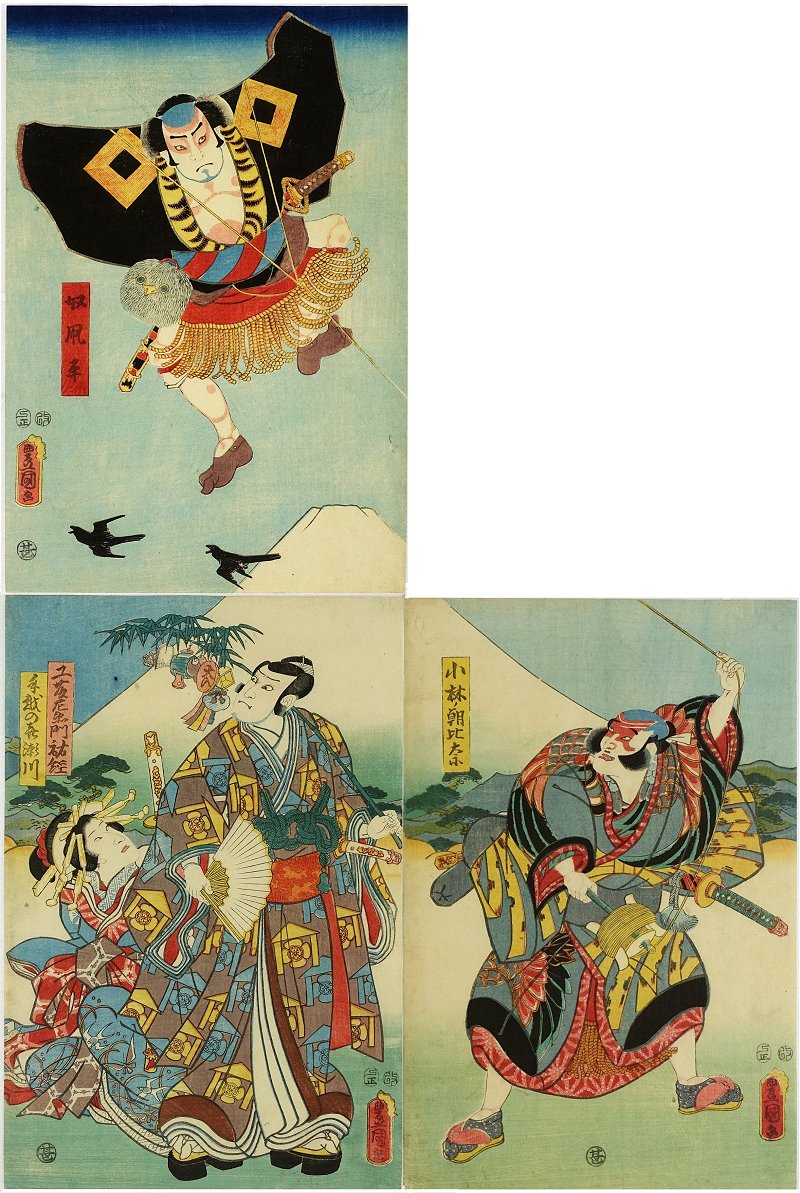| |
KUNISADA(Toyokuni-III)(1786 - 1864)"Ordinary Yakko Kite" (Maruya Edition) |

"Ordinary Yakko
Kite"
(Yakko-dako taira, 奴凧平)
Series: "8 Pieces Collection"
(Hachi Mai-Soroi, 八枚揃)
(Yakko-dako taira, 奴凧平)
Series: "8 Pieces Collection"
(Hachi Mai-Soroi, 八枚揃)
Maruya Edition
1857
Comment - The title of the tetraptych
is written in the red cassette on the upper left panel "奴凧平").
The theme is a kabuki
scene from the stage play "Tegoshi Kise River" ("Tegoshi no
Kise-gawa", "手越の喜瀬川"), as stated in the yellow cassette, lower
left panel. Mount fuji is to be seen in the background. The
set is divided from the mountain by hills and trees.
A flying Yakko or man kite ("yakko-dako", "奴凧"), played by kabuki star Ichikawa Ichizō-III (市川市蔵) is floating in the sky. He wears the distinctive clothing of a yakko or low ranking servant, a kimono with a striped collar and a diamond crest on the shoulders. his sword tucked in the obi behind him. The Yakko carries a funny bag with two eyes and suggested bird-of-prey beak on a kind of wooly head, maybe depicting a head of an owl. The bag is tied to his obi. The Yakko hangs in the air, his sleeves extended like wings, looking down with a frown. While in the air, two swallows are crossing below him.
The kite is tied to a kite line extending over the lower right selvage, to the kabuki character Kobayashi Asahina ('小林 朝比奈') on the lower right panel. Strongman Asahina in his warrior outfit, holds the kiteline with his left hand, and a kite spool in his right. Kabuki star Nakamura Fukusuke-I (中村福助) plays the character 'Kobayshi Asahina' ('小林 朝比奈') as written on the yellow cassette right panel, upper left side.
The lower left panel shows a beauty with a
smile watching her her companion, actor Saemon Suketsune
(左衛門祐経) aka Nakamura Shikan (中村芝翫), written in the red
cassette. He seems to be alarmed, his eyes wide open. The
actor has a sword tucked in his obi, and carries a bamboo
stick over his shoulder with lots of small gifts at the leafy
end of the carrying stick. An oval pendant
shows the characters "大入" ("Ōiri") meaning
"full to the brim", maybe a hint for the kabuki theater
in the sense of "full house" or "sell out".
The same setting of panels of the Tsujioka-ya
Bunsuke (辻岡屋文助) edition shows geese flying in the sky.
Geese especially when flying in triangular formation across
the moon indicate autumn. This Maruya edition shows swallows.
The swallow (tsubame) comes from the south in spring, and
leaves in autumn, Thus the swallow is the typical indicator
for summer. Maybe the two different sets hint to the different
theater seasons.
Series - "8 Pieces Collection" or
"Hachi Mai-Soroi" (Yuika Ogawa Yukiyuki Omi - Kunihisa-ga
Sandai-Toyokuni-ga - Hachi Mai-soroi,
濡衣女鳴神 近江八勇之内 国久画 三代豊国画 八枚揃)
Artist - see Biography
Signature - Toyokuni-ga (豊国 画), in streched oval brownish-red toshidama cartouche (Otoshidama-in, 年玉印), on all panels; date and censor seals above otoshidamas on all panels
Publisher - Maruya (丸屋); circular seals lower left or center, on all panels
Image Size - 36.0 x 24.0cm (14 1/6" x 9 1/2") (each panel)
Condition - single panels (three parts of a tetraptych); nishiki-e (cloured woodblock); vertical ôban (ôban tate-e);
Artist - see Biography
Signature - Toyokuni-ga (豊国 画), in streched oval brownish-red toshidama cartouche (Otoshidama-in, 年玉印), on all panels; date and censor seals above otoshidamas on all panels
Publisher - Maruya (丸屋); circular seals lower left or center, on all panels
Image Size - 36.0 x 24.0cm (14 1/6" x 9 1/2") (each panel)
Condition - single panels (three parts of a tetraptych); nishiki-e (cloured woodblock); vertical ôban (ôban tate-e);